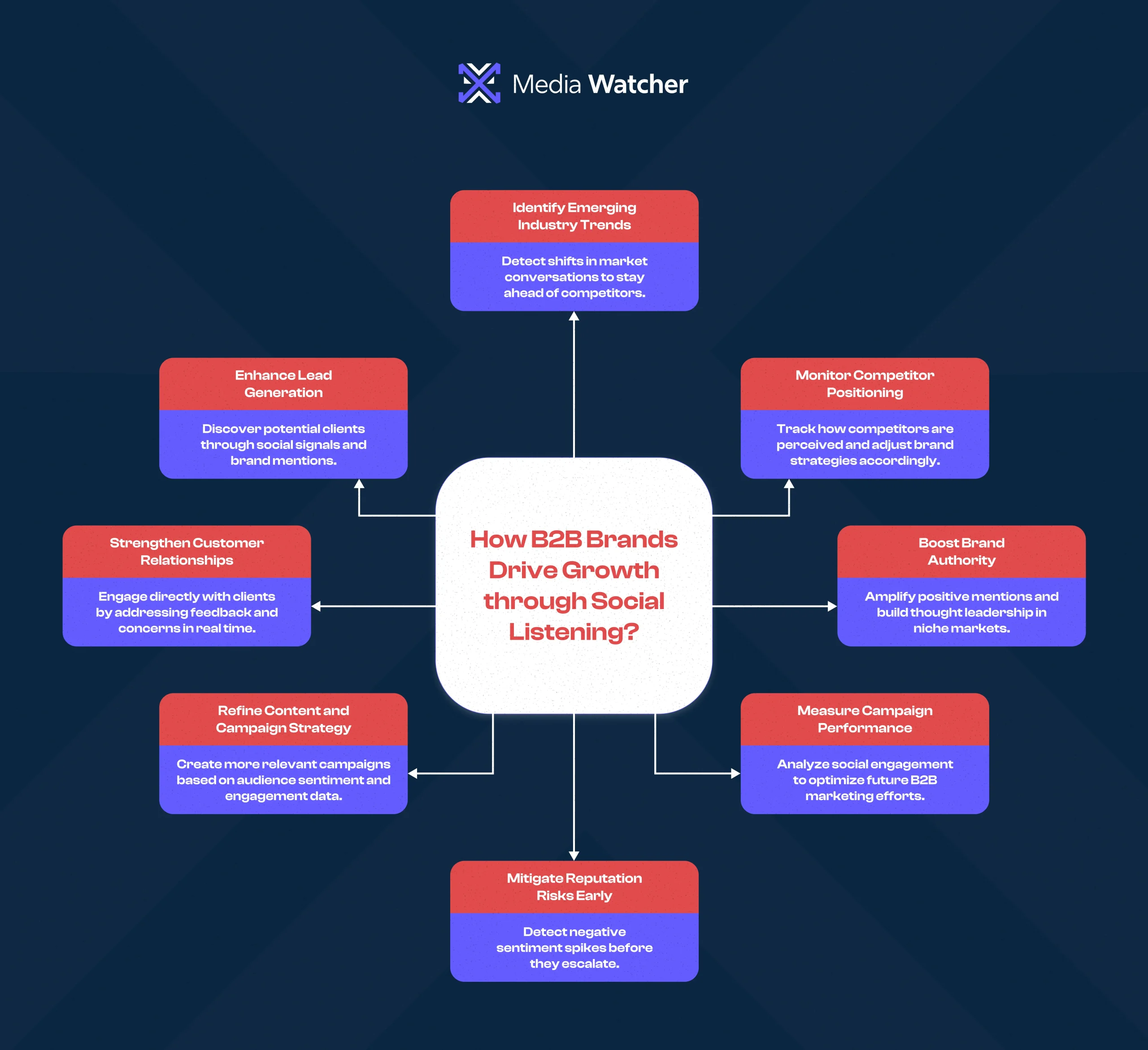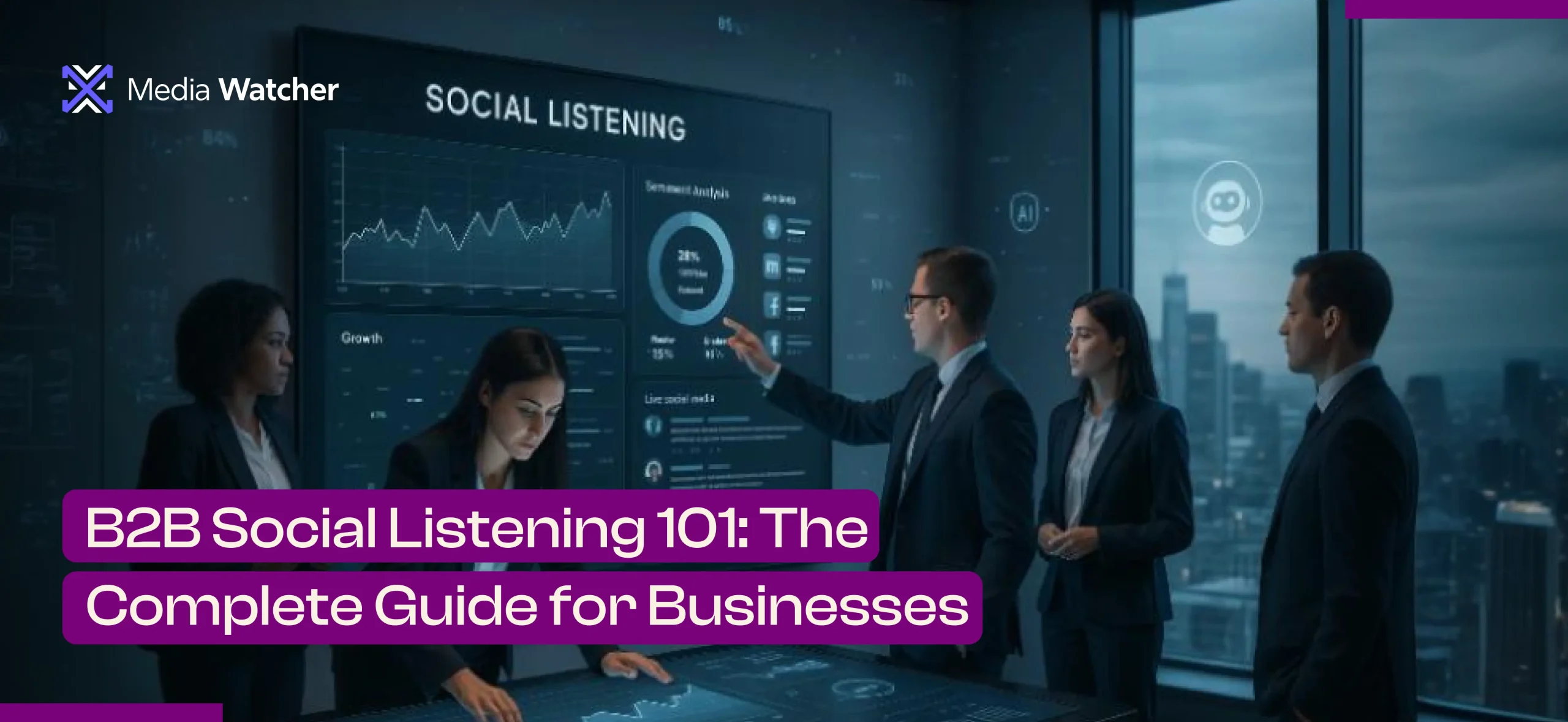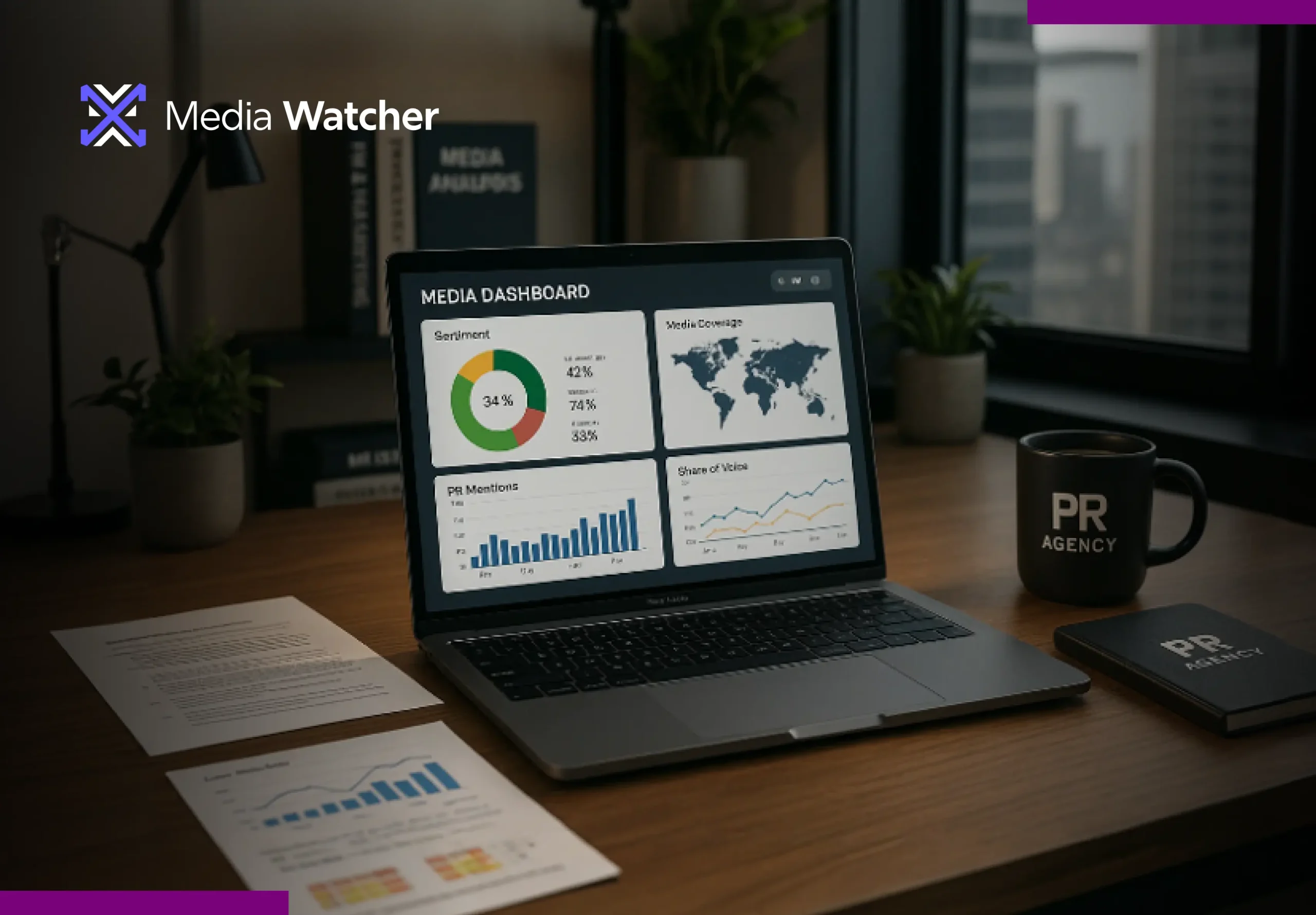According to Forrester, 74% of buyers search online and then discuss purchases with a sales representative, resulting in digital research making B2B buying decisions. As the digital dialogue takes place everywhere, even in intimate circles, there is no longer a choice between knowing what your audience is saying and not. What do businesses know that is not visible? How do they anticipate changes in the market, and how do they relate with potential customers in a significant way?
In this guide, you will learn how B2B social listening tools can help you keep up with conversations, sentiment analysis, and determine what opportunities your competitors might be missing.
What is B2B Social Listening?
B2B social listening is a method of listening, analyzing, and deriving insights on internet-based discussions that influence the manner in which businesses perceive and respond to one another. It helps companies get a sense of the true emotions behind the online debates, whether it is their brand, their competitors, or industry topics.
It is not just a counting of mentions. It involves evaluation of the situation, areas of conversation between clients, problems they pose, and reactions to the trends in professional networks. In the case of business to business social listening, it assists a company to identify the untapped opportunities, refine their message, and also respond to the shifts in the industry faster than their competitors.
It is one thing to learn the B2B social listening, and it is another to understand how it fits with other listening paradigms. Even though any business is interested in knowing what is being discussed about its brand, the approach to this is different depending on whether the audience is the consumers or other organizations. When discussing the contrast between B2B and B2C social listening, we can say that both can bring out various types of insights and growth strategies.
How do B2B and B2C Social Listening Differ in Purpose and Impact?
Although both are directed at understanding the emotions of the audience, B2B and B2C social listening have different goals. B2C listening tends to rest on the customer experience, reviews, and purchase patterns, and these are relevant in consumer marketing.
In contrast, social listening for B2B deals with the trends in the industry, the positioning of the competitors, the regulatory sentiment, and the professional discussions, which determine the future of long-term partnerships. It is about emotions and the practical experience that informs the image and the judgment in the professional ecosystem.
How are Social Monitoring and Social Listening Different from Each Other?
Social monitoring and social listening may sound alike, but they fulfill different functions in the perception of a brand. The distinction exists in their depth and intent.
Social monitoring records the shallow, surface activity, mentions, tags, reviews, and direct messages. It is also instant and responsive, allowing teams to deal with engagement and customer concerns in real-time or recognize feedback as it comes.
Social listening, however, goes more in-depth. It determines new trends, repeated feelings, and the sentiment behind online discussions. It does not just help businesses to react but also to forecast, plan, and put themselves in the right place in the market.
How to Build a Step-by-Step B2B Social Listening Framework?
The overall B2B social listening model involves the following steps, which are provided below to have a better understanding:
1. Define Clear Objectives
Any effective B2B social listening plan begins with a clear objective. First, decide if you want to manage brand reputation, track competitors, or generate leads because goals are measurable, so when you have objectives set, you will know that defined actions will generate value and support the larger business plans instead of creating fragmented or overlapping data.
2. Determine Key Digital Channels
B2B negotiations are made outside the mainstream. The communication between professionals and decision-makers typically occurs on niche industry forums, trade association networks, and blogs. Mapping these digital spaces can make you concentrate on sources that are actually important to the target audience so that all the insights you capture become relevant and actionable.
3. Design a Strategic Keyword Plan
Business to business social listening is based on an effective use of keyword strategy. This cannot be just confined to finding brand name mentions; it must have industry-specific phrases, competitor mentions, and recurring client pain points. Negative keywords are used to narrow down all irrelevant mentions and improve the accuracy of the data. This will assist your analysis and help you avoid clutter. The more exact choice of keywords results in the elimination of less relevant mentions and a more accurate perception of discussions.
4. Selection of the B2B Social Listening Tools
The choice of credible B2B social listening tools is everything. The finest tools are not just mere track mentions, but they read sentiment, tone, and context. Find solutions that provide real-time notifications, multilingual support, and integration with CRM or analytics. These features transform unstructured data into more organized information, which can be acted upon by the teams in real-time.
5. Create Dashboards and Categorize Insights
After the tool is configured, create design dashboards that present findings and classify them into meaningful categories like customer sentiment, competitor activity, and market trends. Visualization of data simplifies the process of interpreting complex patterns as it allows marketing and strategy teams to make well-informed decisions on the basis of data-oriented conclusions.
6. Decision-Making Through Insights
Information only becomes effective when it brings about change. Use the acquired knowledge to maximize marketing activities, modify brand communication, and improve engagement with clients. Encourage cross-functional activities among various departments such as marketing, product, and sales so that every team will be no less aware of the intelligence, resulting in a coordinated development of the brand.
7. Make Framework Adaptable
Social listening is never a one-time thing but a lifelong process. This calls on businesses to change and update tracked keywords, sources, and competitors on a regular basis in line with the behavior change in the market. Moreover, companies should have a flexible structure of ongoing marketing that keeps them open to new debate and changing customer demands. This level of deep social media intelligence, based on active social listening, can then provide them with a strategic edge.

Features to Look for in B2B Social Listening Tools
The development of a useful B2B social listening solution will necessitate tools that transcend surface-level monitoring. The appropriate B2B social listening platform needs to provide valuable insights, facilitate decision-making, and respond to market demands. The following are vital characteristics of a tool that is effective in terms of B2B communication and brand intelligence.
1. Real-Time Tracking of Alerts
In the business-to-business world, conversations are quick-tempered, and an overlooked mention will cost you a contract. Real-time tracking allows a business to monitor a conversation through its progression, like a client request, news about their competitor, or market advancements. This real-time notification of teams about significant mentions contributes to fast response and builds the image of a brand.
2. Sentiment Context Analysis
Raw data do not carry much information unless it is contextualized. A good B2B social listening software must be able to identify positive, neutral, and negative tones. The knowledge of the emotional nuances will give a better idea about the ways your brand is understood in various markets and allow you to develop more effective communication strategies that can attract professional audiences.
3. Cross-Regional and Multilingual Coverage
B2B selling does not easily limit itself to one geography. The applications facilitating multilingual tracking and cross-regional reach enable companies to gain universalized data and view how their clients perceive them across different markets. This international perspective assists businesses in highlighting domestic market moods and regional trends that shape brand perception on a global scale.
4. Competitor and Industry Tracking
A perfect social listening strategy revolves around competitor monitoring. The best instruments provide comparative dashboards to aid in comprehending where the brand stands relative to others in terms of the share of voice and the degree of engagement. This feature highlights the strengths and weaknesses of the rivals, and also pinpoints the market gaps that the brand can strategically use to bridge.
5. High-level Data Filtering and Classification
A B2B tool must not merely gather mentions but also filter them. Highly developed filters, including source classification and topic segmentation, promote only valuable insights. Categorized data is used to enable marketing and communication teams to be focused on actionable intelligence instead of being overwhelmed by raw and unstructured information.
6. Integration with Analytics and CRM Systems
Social listening is more important when used in combination with internal systems. The platforms that integrate ideally with the analytics dashboard or CRM systems give a full picture of client interaction. Such integration connects marketing intelligence to sales strategy, whereby insights are directly applied in lead nurturing and content planning.
7. Reporting and Customizable Dashboards
The insights needed by different departments are different. Dashboards may be personalised, and automated reporting can be enabled to allow every team, marketing, communications, or product development to view the most relevant metrics in relation to their goals. These personalized views simplify the process of tracking performance and are useful in transforming raw data into insights that can be used in decision-making.
How Businesses Can Track and Evaluate B2B Social Listening Outcomes?
The measurements of the effect of B2B listening on companies involve the social media monitoring of a mixture of both qualitative and quantitative indicators. As a case in point, tracking sentiment in real time can show how messaging or the rollout of a new product is evolving; in many instances, businesses that react quickly to swings in negative sentiment tend to avoid an expensive PR crisis.
The share of voice measurements indicate the frequency and saliency of a brand in the industry discussion. Brands with an increasing voice share are regarded as leaders. The quality of engagement, remarks, considerate mentions, and professional chats tends to indicate a greater level of trust than likes. Moreover, connecting the results of listening to the lead generation and sales corridors enables companies to directly correlate social vigilance with income, such as viewing what content or announcement threads resulted in inquiries.
Lastly, the speed at which one picks up on emerging issues or competitor moves by recording response metrics will indicate the acuity of the listening protocol. It can be used to identify faster and, in most instances, offers out-of-the-ordinary value by enabling a strategic advantage.
How Media Watcher Helps B2B Businesses Strengthen Social Listening Protocols for Enhanced Brand Visibility?
Media Watcher allows the B2B companies to take social media data and convert it into decision-making guidelines. Recording live discussions on niche forum sites helps the brands get a feel for the stakeholders, track the actions of their competitors, and detect the trends in the industry that are shifting. This proactive strategy makes businesses beat their competitors. The following characteristics of Media Watcher can assist in reaching this objective:
- Real-Time Alerts: Brands can respond within 200 milliseconds by receiving a notification of any alert, preventing any problem that could cause a brand reputation problem.
- Historical Data Access: Use decades of media data to compare the present mood with the past, helping to forecast trends and plan strategically.
- Contextual Sentiment Analysis: Differentiate between long-term interests and short-term views by understanding the context of mentions.
- Custom Media Outlet Analysis: Customize monitoring to particular media outlets that are pertinent to your industry, so that relevant insights are gathered.
Contact the Media Watcher team and book a free demo today!




